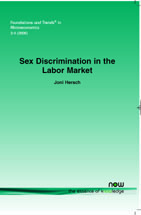Sex Discrimination in the Labor Market
By Joni Hersch, Vanderbilt University Law School, USA, joni.hersch@vanderbilt.edu
Abstract
This paper examines sources of gender pay disparity and the factors that contribute to this pay gap. Many researchers question the role of discrimination and instead attribute the residual pay gap to gender differences in preferences. The main issue considered in this paper is whether gender differences in choices, especially with respect to the family and household, are indeed responsible for the gender pay gap, or whether discrimination plays a role. On balance, the evidence indicates that sex discrimination remains a possible explanation of the unexplained gender pay gap. This is consistent with the continuing high profile sex discrimination litigation suggestive of on-going inferior treatment on the basis of sex.
Sex Discrimination in the Labor Market
Women have made huge advances relative to men in the labor force, occupational status, and educational attainment, but women continue to earn less than men. While the gender pay gap has narrowed, a substantial gap remains. Sex Discrimination in the Labor Market examines sources of this pay disparity and the factors that contribute to this gap. Whether sex discrimination plays a role in the gender pay gap is a topic of considerable debate. Many researchers question the role of discrimination and attribute the residual pay gap to gender differences in preferences, especially with respect to balancing work with family responsibilities. Sex Discrimination in the Labor Market shows that sex discrimination contributes to the unexplained gender pay gap, which is consistent with high profile sex discrimination litigation suggesting continuing bias in the labor market on the basis of sex.
